This topic may seem confusing the first time. Don't despair and give up on learning. Understanding will come in any case. If not immediately, then a little later. The main thing is not to give up and continue to study hard.
In previous examples, we divided a single-digit number by a single-digit number, and this did not give us too much trouble. Now we are going to divide a multi-digit number by a single-digit number.
If you do not understand what single and multi-digit numbers are, we advise you to study the previous lesson, which is called multiplication.
Using the standard algorithm
To divide a multi-digit number by a single-digit number, you must first look at the first digit of that multi-digit number and see if it is greater than the divisor. If it is greater, then divide, and if not, then check if the first two digits of the multi-digit number are greater than the divisor. If the first two digits are greater than the divisor, then divide, and if not, then check if the first three digits of the multi-digit number are greater than the divisor. And so on until the first division is done.
Is it difficult? Not at all, if we look at some examples.
Example 1. Find the value of the expression 25 : 3
25 is a multi-digit number, and 3 is a single-digit number. Apply the rule. Look at the first digit of a multi-digit number. The first digit is 2. Is two more than three? No. So we look at the first two digits of a multi-digit number. The first two digits form the number 25. Is twenty-five more than three? Yes, it is greater. So we divide the number 25 by 3. Write this expression with help of long divison and start dividing:

How many threes are in 25? If the answer is difficult at first, you can look at the multiplication table by three. There you need to find a product that is less than 25, but very close to it or equal to it. If you find such a product, you need to take from there the multiplier that gave such a product:
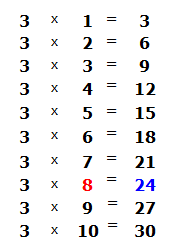
This is a multiplication table by three. In it, you need to find a product that is less than 25, but very close to it or equal to it. Obviously, this is the product of 24, which is highlighted in blue. From this expression, you need to take away the multiplier that gave that product. This is the multiplier 8, which is shaded in red.
This eight answers the question of how many threes are in the number 25. Write it like this:

Now take out the remainder. To do this, multiply the quotient by the divisor (8 by 3) and write the resulting number under the divisor:

Now subtract the number 24 from the divisor and get 1. This will be the remainder:
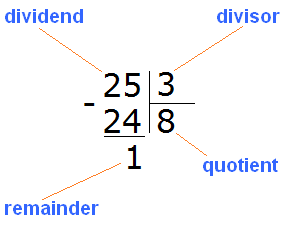
25 : 3 = 8 (1 left over)
(8 x 3) + 1 = 24 + 1 = 25
The last remainder is always less than the divisor. If the last remainder is greater than the divisor it means that division is not complete.
In the example above, the last remainder was 1 and the divisor was 3. One is less than three, so division is complete. The last remainder smaller than the divisor indicates that it does not contain numbers equal to the divisor.
In our example, if you ask the question "how many threes are in a unit?", the answer is "none," because a unit contains no threes because it is less than a three.
Example 2. Divide 326 by 4.
Look at the first digit of 326. The first digit is 3. Is it larger than the divisor of 4? No. Then we check the two digits of the divisor. The two digits of the divisor form number 32. Is it greater than the divisor of 4? Yes, it is. That's why we divide it. Write this expression:
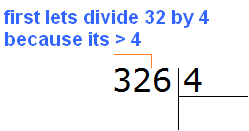
Now we ask the question, "How many fours are in the number 32? There are eight fours in the number 32. This can be seen in the multiplication table by four:
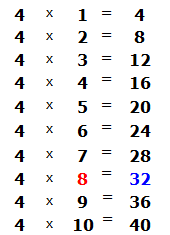
This eight, which is highlighted in red, answers the question how many fours are in 32. Write it:
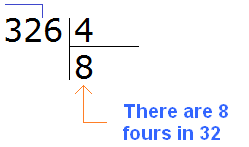
Now multiply 8 by 4 to get 32 and write that number under the divisor. Then subtract this number from 32. We obtain 0. Since the solution is not yet complete, do not write zero:
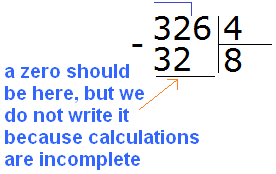
The first number 32 is divided. It remains to divide the remaining 6. To do this, tear down that six:

Now divide 6 by 4. To do this, we ask the question, "How many fours are in a six?" There is one four in a six; you can see this by picturing the six as six sticks:
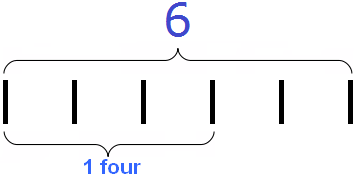
Write one in the right-hand corner of our answer:
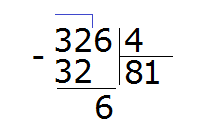
Now multiply our one by the divisor (1 by 4) and write the resulting number under the six:
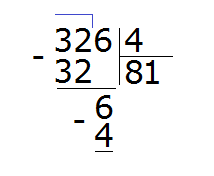
Then we subtract 4 from 6 and get the number 2, which is the remainder:
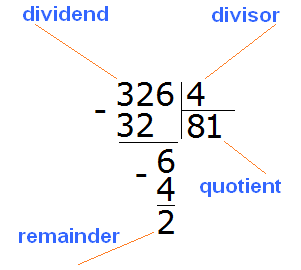
We got 326 : 4 = 81 (2 in the remainder)
Check: (81 x 4) + 2 = 324 + 2 = 326
The procedure in which we look for the first number to divide by comparing whether it is greater than the divisor or less is called finding the first incomplete divisor.
Let's go back to the previous example 326 : 4. The first incomplete divisor in this expression was 32 because we divided it first.
And in the example 25 : 3, the first incomplete divisor was 25.
Example 3. Find the value of the expression 384 : 5
Write this expression:

First we find the first incomplete divisor. The first digit is smaller than the divisor, so we check two digits. The two digits together form the number 38, which is greater than the divisor. This number will be the first incomplete divisor. We will divide it by the divisor first:

How many fives are in the number 38? If it is difficult to answer right away, you can look at the multiplication table for five and find a product that is less than 38, but very close to it or equal to it. Having found such a product, you need to take from there the multiplier that will answer our question:
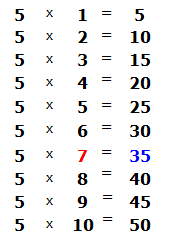
This is the multiplication table by five. Find a product that is less than 38, but very close to it or equal to it. Obviously, it is the product of 35, which is highlighted in blue. From this expression, we take away the multiplier that gave that product. This is the multiplier 7, which is highlighted in red.
This seven answers the question of how many fives are in the number 38. Write this seven in the right corner of our example:
Multiply 7 by 5 to get 35 and write it under 38:
Now subtract 35 from 38 to get 3:
This triplet is the remainder that was left undivided by dividing 38 by 5. But you can see that we still have to divide 4. This 4 we will take down and divide together with the 3:
You can see that after we took down the four, it together with the three formed the number 34. We will divide this number 34 by 5. To do this, we again ask the question, "how many fives are in the number 34?" You can look again at the multiplication table for five and find a product that is less than 34, but very close to it or equal to it:

You can see that in the multiplication table by five, the number 30 is less than our 34, but close to it. From this expression we take the multiplier 6, which answers our question. Write this six in the right corner of our example:
Now multiply 6 by 5 to get 30 and write that number under 34:
Now subtract 30 from 34 and you get 4. This four is the remainder of dividing 384 by 5.
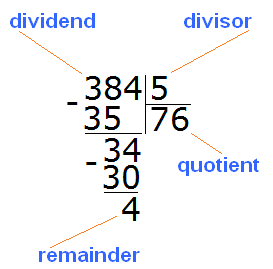
384 : 5 = 76 (and 4 left over)
Check: (76 x 5) + 4 = 380 + 4 = 384
Example 4. Find the value of expression 8642 : 4
This example is a little more complicated. Write this expression in the corner:

The first digit of 8 is greater than the divisor. This eight will be the first incomplete divisor. Dividing 8 by 4, we get 2

Now multiply 2 by 4 and you get 8. Write this eight under the first incomplete divisor:

Pull out the remainder: 8 - 8 = 0. The residue from dividing 8 by 4 is zero. We do not write down zero, because the solution of the example is not complete.
Next, we take down the number 6 and divide it by the divisor, and get 1
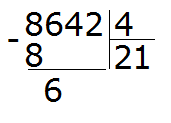
Multiply 1 by 4 to get 4. Write this four under the six that has been taken down. Then take out the remainder by subtracting four from six:

The remainder is 2. This is the remainder left over from dividing 6 by 4.
Now we take the next digit out of the divisor. This is the digit 4. This four, together with the previous residue 2, makes 24. We divide it by the divisor. We get 6
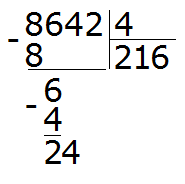
Multiply 6 by 4 to get 24. Write this number under 24
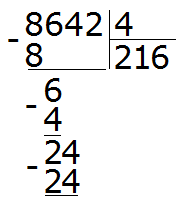
Pull out the remainder: 24 - 24 = 0. Zero is the residue from dividing 24 by 4. Zero, as we have already agreed, is not written down. Then we take down the last digit of 2
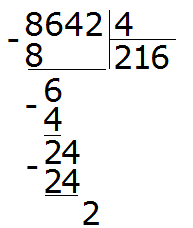
Here begins the most interesting part. The two is the last digit that we took down, and we have to divide it by the divisor 4. But the point is that the two is smaller than the four, and the divisor must be larger than the divisor. If we ask the question "how many fours are in a two?", the answer is zero because a two is less than a four and cannot contain a number greater than itself.
Therefore, two divided by four is zero:
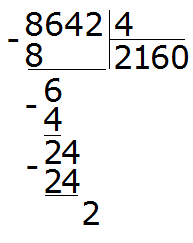
Multiply 0 by 4 to get 0. Write that 0 under the 2:
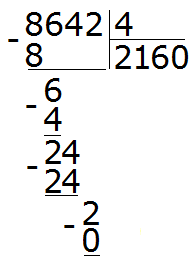
Now find the remainder: 2 - 0 = 2. The two is the remainder of dividing 8642 by 4. This completes the example:
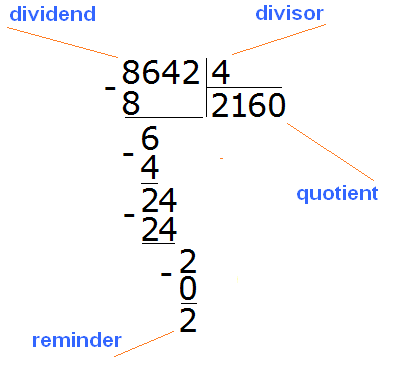
8642 : 4 = 2160 (2 left over)
Check: (2160 x 4) + 2 = 8640 + 2 = 8642


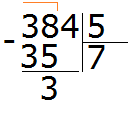
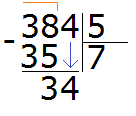
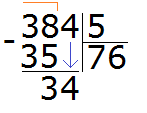
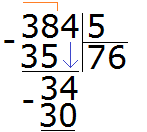
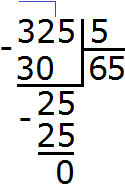

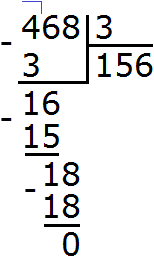
2. If you find an error or inaccuracy, please describe it.
3. Positive feedback is welcome.